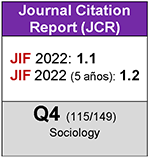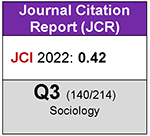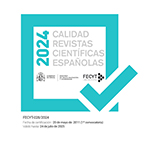The Switch to Telephone Survey Mode in the CIS Barometer. A Comparison with ICC Time Series
DOI:
https://doi.org/10.5477/cis/reis.185.145-162Keywords:
Centre for Sociological Research, Face-to-Face Surveys, Telephone Surveys, Data Collection MethodologyAbstract
In April 2020, Spain’s Centre for Sociological Research (CIS) changed its survey mode from face-to-face (PAPI/CAPI) to telephone-based (CATI). In this study we examine the impact of this change on two CIS barometer variables: marital status and education level. We describe their evolution from 2013 to 2023 using the Consumer Confidence Index (ICC), a continuous survey that has always been telephone-based, as a comparative reference. As we will see, the change in mode produced discontinuities in the measurement of education level, with implications for the quality and interpretation of results. In addition, the evidence suggests that the private research companies the CIS contracted to carry out telephone fieldwork had their own biases that must be taken into account for series comparison and monitoring.
Downloads
References
Arnau, Jaume (2001). Diseños de series temporales. Técnicas de Análisis. Barcelona: Edicions Universitat de Barcelona.
Balaguer, Jaime (2022). El recuerdo de voto en las encuestas. Un análisis exhaustivo a partir del caso español. Madrid: Consejo Superior de Investigaciones Científicas.
Bosch, Josep L. y Torrente, Diego (1993). Encuestas telefónicas y por correo. Colección Cuadernos Metodológicos, n.º 9. Madrid: Centro de Investigaciones Sociológicas.
CIS (2007). La percepción social de las encuestas. Estudio 2676. Banco de Datos del CIS.
CIS (2018). Índice de Confianza del Consumidor-Septiembre 2018. Estudio 3225. Banco de Datos del CIS.
Díaz de Rada, Vidal (2010). Comparación entre los resultados proporcionados por encuestas telefónicas y personales. el caso de un estudio electoral. Colección Opiniones y Actitudes, n.º 66. Madrid: Centro de Investigaciones Sociológicas.
Díaz de Rada, Vidal (2019). «Calidad de respuesta y modo de administración del cuestionario». Revista Internacional de Sociología, 77: 1-18. DOI: https://doi.org/10.3989/ris.2019.77.1.17.135
Dillman, Don; Smyth, Jolene y Christian, Dean (2014). Internet, Phone, Mail and Mixed Mode Surveys. The Tailored Design Method. New York: Wiley. DOI: https://doi.org/10.1002/9781394260645
Fessler, Pirmin; Kasy, Maximilian y Lindner, Peter (2018). «Survey Mode Effects on Measured Income Inequality». The Journal of Economic Inequality, 16: 487-505. DOI: https://doi.org/10.1007/s10888-018-9378-x
Galán, Iñaki; Rodríguez, Fernando y Zorrilla, Belén (2004). «Comparación entre encuestas telefónicas y encuestas “cara a cara” domiciliarias en la estimación de hábitos de salud y prácticas preventivas». Gaceta Sanitaria, 18: 440-50. DOI: https://doi.org/10.1016/S0213-9111(04)72031-2
Groves, Robert y Kahn, Robert (1979). Surveys by Telephone. A National Comparison with Personal Interviews. London: Academic Press.
Heerwegh, Dirk y Loosveldt, Geert (2011). «Assessing Mode Effects in a National Crime Victimization Survey Using Structural Equation Models. Social Desirability Bias and Acquiescence». Journal of Official Statistics, 27: 49-63.
Holbrook, Allyson; Green, Melanie y Krosnick, Jon (2003). «Telephone versus Face-to-face Interviewing of National Probability Samples with Long Questionnaires. Comparisons of Respondent Satisficing and Social Desirability Response Bias». Public Opinion Quarterly, 67: 79-125. DOI: https://doi.org/10.1086/346010
Hox, Joop; Leeuw, Edith de y Klausch, Thomas (2017). «Mixed-Mode Research. Issues in Design and Analysis». En: P. Biemer, E. D. de Leeuw, S. Eckman, B. Edwards, F. Kreuter, L. E. Lyberg, N. C. Tucker y B. T. West (eds.). Total Survey Error in Practice. John Wiley & Sons Inc. DOI: https://doi.org/10.1002/9781119041702.ch23
Jäckle, Annette; Roberts, Caroline y Lynn, Peter (2006). «Telephone versus Face-to-face Interviewing. Mode Effects on Data Quality and Likely Causes». ISER Working Paper Series, 41. University of Essex.
Krosnick, Jon (2002). «The Impact of “No Opinion” Response Options on Data Quality. Non-attitude Reduction or an Invitation to Satisfice?». Public Opinion Quarterly, 66: 371-403. DOI: https://doi.org/10.1086/341394
Lau, Charles; Cronberg, Alexandra; Marks, Leenisha y Amaya, Ashley (2019). «In Search of the Optimal Mode for Mobile Phone Surveys in Developing Countries. A Comparison of IVR, SMS, and CATI in Nigeria». Survey Research Methods, 13: 305-318.
Leeuw, Edith de y Zouwen, Johannes van der (1988). «Data Quality in Telephone and Face To Face Surveys. A Comparative Meta-Analysis». En: R. Groves, W. L. Nicholls, J. T. Massey, J. Waksberg, P. P. Biemer y L. E. Lyberg (eds.). Telephone Survey Methodoly. New York: Wiley.
Narayan, Sowmya y Krosnick, Jon (1996). «Education Moderates Some Response Effects in Attitude Measurement». Public Opinion Quarterly, 60: 58-88. DOI: https://doi.org/10.1086/297739
Peña, Daniel (2005). Análisis de Series Temporales. Madrid: Alianza Editorial.
Salinas, José M. y Aguilar, María del C. (2004). «Un análisis comparativo entre la entrevista telefónica y la entrevista presencial en la determinación de la prevalencia de los juegos de azar». Metodología de Encuestas, 6: 119-132.
St-Pierre, Martin y Béland, Yves (2004). «Mode effects in the Canadian Community Health Survey. A Comparison of CAPI and CATI». 2004 Proceedings of the American Statistical Association Meeting. Survey Research Methods. Toronto: American Statistical Association.
Sloan, Matt; Wright, Debra y Barrett, Kirsten (2006). «Data Comparability in a Mixed Mode Telephone and Face to Face Survey of Persons with Disabilities». Mathematica Policy Research Reports.
Tourangeau, Roger y Smith, Tom (1996). «Asking Sensitive Questions. The Impact of Data Collection Mode. Question Format and Question Context». Public Opinion Quarterly, 6. DOI: https://doi.org/10.1086/297751
Downloads
Published
How to Cite
Issue
Section
License
Copyright (c) 2023 Revista Española de Investigaciones Sociológicas

This work is licensed under a Creative Commons Attribution-ShareAlike 4.0 International License.
Permite Compartir — copiar y redistribuir el material en cualquier medio o formato, Adaptar — remezclar, transformar y construir a partir del material para cualquier propósito, incluso comercialmente.








